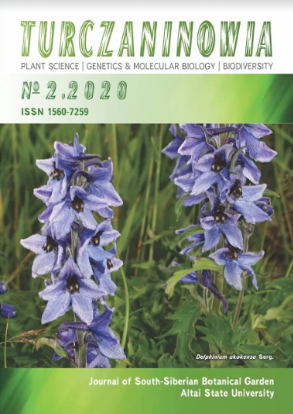An interesting finding of a new for Eurasia North American lichen species Placidium californicum (Verrucariaceae)
Abstract
The description and location of the new to Eurasia lichen species Placidium californicum Breuss, found in the steppe ecotope in “Orenburgskii” Nature State Reserve (Orenburg Region, Russia) are reported. The species is very much similar to P. squamulosum (Ach.) Breuss, differing from it in subglobose spores with thickened walls, thinner rhizohyphae, 3.5–4.5 μm thick (in P. squamulosum 4.5–6.5 μm thick), and the absent or not clearly developed lower cortex. Based on all the currently known locations, a map of distribution of P. californicum has been compiled. The chorology issues and the ecological features are discussed. The lichen is found in arid and subarid areas of the temperate zone; it inhabits mainly in grassy and shrubby phytocenoses (steppes, prairies, deserts) on mineral (sandy and clay-sandy) substrates enriched with various salts, including carbonate, gypsum-containing and slightly saline soils.
Downloads
Metrics
References
Breuss O. 2002. Placidium A. Massal. In: Lichen Flora of the Greater Sonoran Desert Region. I. Eds. T. H. III Nash, B. D. Ryan, C. Gries, F. Bungartz. Arizona: Lichens Unlimited, Arizona State University, Tempe. Pp. 384–393.
Breuss O., Bratt C. C. 2000. Catapyrenoid lichens in California. Bulletin of the California Lichen Society 7(2): 36–43.
Doubt J., Shorthouse D. 2020. Canadian Museum of Nature Herbarium. Version 1.116. Canadian Museum of Nature. Occurrence dataset https://doi.org/10.15468/kowta4 accessed via GBIF.org. https://www.gbif.org/occurrence/1804501511 (Accessed 21 January 2020).
Morse C. 2019. R. L. McGregor Herbarium Lichen Collection. University of Kansas Biodiversity Institute. Occurrence dataset https://doi.org/10.15468/0xlhx0 accessed via GBIF.org. https://www.gbif.org/occurrence/866384630 (Accessed 21 January 2020).
Ramirez J., Tulig M., Watson K., Thiers B. 2020. The New York Botanical Garden Herbarium (NY). Version 1.17. The New York Botanical Garden. Occurrence dataset https://doi.org/10.15468/6e8nje accessed via GBIF.org. https://www.gbif.org/occurrence/1930390521 (Accessed 21 January 2020).
University of Minnesota Bell Museum. 2020a, b, c. Bell Museum lichens. Occurrence dataset https://doi.org/10.15468/up3htf accessed via GBIF.org. (a) https://www.gbif.org/occurrence/2266168390 (b) https://www.gbif.org/occurrence/2266179311 (c) https://www.gbif.org/occurrence/2266168032 (Accessed 07 July 2020).
Turczaninowia is a golden publisher, as we allow self-archiving, but most importantly we are fully transparent about your rights.
Authors may present and discuss their findings ahead of publication: at biological or scientific conferences, on preprint servers, in public databases, and in blogs, wikis, tweets, and other informal communication channels.
Turczaninowia allows authors to deposit manuscripts (currently under review or those for intended submission to Turczaninowia) in non-commercial, pre-print servers such as ArXiv.
Authors who publish with this journal agree to the following terms:
- Authors retain copyright and grant the journal right of first publication with the work simultaneously licensed under a Creative Commons Attribution License that allows others to share the work with an acknowledgement of the work's authorship and initial publication in this journal.
- Authors are able to enter into separate, additional contractual arrangements for the non-exclusive distribution of the journal's published version of the work (e.g., post it to an institutional repository or publish it in a book), with an acknowledgement of its initial publication in this journal.
- Authors are permitted and encouraged to post their work online (e.g., in institutional repositories or on their website) prior to and during the submission process, as it can lead to productive exchanges, as well as earlier and greater citation of published work (See The Effect of Open Access).





